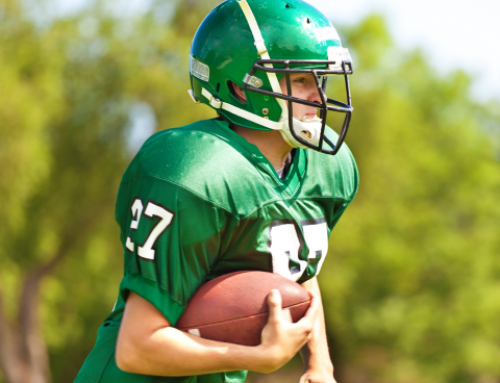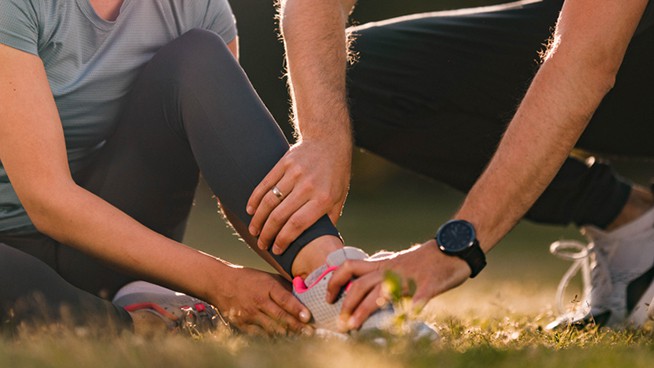3 Training Keys For Reducing ACL Injuries

Thinkstock
Awareness of ACL (anterior cruciate ligament) knee injuries is increasing, yet prevention programs are still lacking. ACL injuries continue to have devastating consequences for athletes, especially younger ones.
Young athletes compete in more games but are more inactive off the field than ever before. That’s a bad combination. Overzealous parents and coaches push them to compete at the highest level through early specialization and year-round play, while neglecting the most important aspect of sports development: training.
If you combine over-competing, inactivity and a lack of physical preparation, you have a recipe for disaster.
Many studies over the past few years have found that ACL prevention programs actually improve performance as well as prevent injury. A study by Noyes and Westin in 2011 found that a program that reduces ACL injuries also concurrently improves athletic performance variables. The study proved that prevention programs improve strength, vertical jump, speed and agility, confirming what many of us in the sports performance world already knew—that the key to reducing ACL injuries and increasing performance is improving athletes’ efficiency in fundamental movement patterns.
By efficiency, I mean an athlete’s ability to control and manipulate his or her body through a variety of fundamental and sport-specific movement patterns. This ability is evaluated during ACL injury risk screenings with exercises like the Drop Jump, Single-Leg Squat and Single-Leg Hop and Stop. These screens look at the athlete’s ability to control and produce force, both of which are affected by the neuromuscular system.
Athletes who are “at risk” have difficulty with the screens and most likely exhibit neuromuscular deficits in other fundamental movements. A neuromuscular training intervention consists of exercises targeted to improve the ability to accelerate, decelerate, cut, jump and land.
These prevention programs share many of the same general principles. A program that includes each of the following will decrease ACL risk.
1. Comprehensive Dynamic Warm-Up
Time and again, we come back to the warm-up. The benefits of a comprehensive dynamic warm-up include:
- Improving nervous system function
- Decreasing viscosity of synovial fluid
- Improving alignment and posture
- Increasing muscle temperature, and therefore flexibility
- Improving proprioception, balance, and single leg dynamic stability
- Releasing catecholamines (such as norepinephrine and epinephrine)
What does a comprehensive dynamic warm-up consist of? Think of it as an abbreviated gym class. Many of the movements kids used to do in P.E. form a great base for a dynamic warm-up. It should include:
- Foundational movements (Bridges, Squats, Lunges, etc.)
- Taking each joint of the body through a full range of motion.
- Reinforcing appropriate posture through each movement
- Challenging body control through unilateral and asymmetrical stances
- A variety of multi-directional locomotion patterns (skips, shuffle, carioca, etc.)
Now you’re ready for the next step.
2. Deceleration Training (Landing and Decelerating)
It’s easy to be amazed at how fast and high an athlete runs and jumps. Yes, these are amazing feats of athleticism, but training exclusively to develop these athletic attributes may leave you at risk for an ACL injury. The deceleration (landing, stopping and cutting) that comes after acceleration is where most ACL injuries occur.
When training for deceleration, it is important that you move in a variety of different directions prior to slowing down or landing in “triple flexion.” Triple flexion involves flexion of the hip, knee and ankle while keeping each of those joints aligned from the front. In a dysfunctional triple flexion position, the knee caves inward when you land or decelerate. This type of movement dysfunction means you are at increased risk for ACL injury.
When training for deceleration, it is imperative to take proper progressions. There are three major ways to progress while doing jumps, hops or leaps:
a. Foot Patterning
- Two Legs to One Leg
- One Leg to Opposite Leg (Leap)
- One Leg to Same Leg (Hop)
b. Different Planes
- Sagittal (Forward/Backward)
- Frontal (Side-to-Side)
- Transverse (Rotational)
c. Varying Effect of Gravity
- Ground to a Box (gravity eliminated)
- Ground to Ground
- With Small Bounce When Landing
- Continuous in the same or a different direction
3. Strength Training
Strength training is the third important component of any ACL injury prevention program. Many exercises train stabilizer muscles, which are critical to help you control your body during fundamental and sport-specific movement patterns. The one common theme is that the exercise is not performed in a symmetrical stance (think traditional Deadlift or Squat).
Strength training the lower body in an asymmetrical stance (lunging variations) and single-leg position increases activity of stabilizer muscles, such as the gluteus medius and quadratus lumborum. These muscles are critical for maintaining stability in the frontal and tranverse plane, which is where ACL injuries often occur. When your knee drifts inward, you lack control in the frontal and transverse plane. In addition, sport-specific movements are rarely symmetrical in nature and require you to move from one leg to the other as you run up and down the court or field before decelerating and moving in a new direction. Therefore, it is extremely important to train for controlling these types of movement patterns.
- Lunge Matrix
- Single-Leg Box Squat (with opposite leg in front)
- Skater Squat (with opposite knee bent)
- Elevated Single-Leg Squat (with opposite leg behind)
Read More:
- 3 Exercises to Prevent ACL Injuries
- How to Prevent ACL Injuries in Basketball
- 3 ACL Injury Prevention Exercises for Women
- 4 Exercises to Prevent ACL Injuries
RECOMMENDED FOR YOU
MOST POPULAR
3 Training Keys For Reducing ACL Injuries

Thinkstock
Awareness of ACL (anterior cruciate ligament) knee injuries is increasing, yet prevention programs are still lacking. ACL injuries continue to have devastating consequences for athletes, especially younger ones.
Young athletes compete in more games but are more inactive off the field than ever before. That’s a bad combination. Overzealous parents and coaches push them to compete at the highest level through early specialization and year-round play, while neglecting the most important aspect of sports development: training.
If you combine over-competing, inactivity and a lack of physical preparation, you have a recipe for disaster.
Many studies over the past few years have found that ACL prevention programs actually improve performance as well as prevent injury. A study by Noyes and Westin in 2011 found that a program that reduces ACL injuries also concurrently improves athletic performance variables. The study proved that prevention programs improve strength, vertical jump, speed and agility, confirming what many of us in the sports performance world already knew—that the key to reducing ACL injuries and increasing performance is improving athletes’ efficiency in fundamental movement patterns.
By efficiency, I mean an athlete’s ability to control and manipulate his or her body through a variety of fundamental and sport-specific movement patterns. This ability is evaluated during ACL injury risk screenings with exercises like the Drop Jump, Single-Leg Squat and Single-Leg Hop and Stop. These screens look at the athlete’s ability to control and produce force, both of which are affected by the neuromuscular system.
Athletes who are “at risk” have difficulty with the screens and most likely exhibit neuromuscular deficits in other fundamental movements. A neuromuscular training intervention consists of exercises targeted to improve the ability to accelerate, decelerate, cut, jump and land.
These prevention programs share many of the same general principles. A program that includes each of the following will decrease ACL risk.
1. Comprehensive Dynamic Warm-Up
Time and again, we come back to the warm-up. The benefits of a comprehensive dynamic warm-up include:
- Improving nervous system function
- Decreasing viscosity of synovial fluid
- Improving alignment and posture
- Increasing muscle temperature, and therefore flexibility
- Improving proprioception, balance, and single leg dynamic stability
- Releasing catecholamines (such as norepinephrine and epinephrine)
What does a comprehensive dynamic warm-up consist of? Think of it as an abbreviated gym class. Many of the movements kids used to do in P.E. form a great base for a dynamic warm-up. It should include:
- Foundational movements (Bridges, Squats, Lunges, etc.)
- Taking each joint of the body through a full range of motion.
- Reinforcing appropriate posture through each movement
- Challenging body control through unilateral and asymmetrical stances
- A variety of multi-directional locomotion patterns (skips, shuffle, carioca, etc.)
Now you’re ready for the next step.
2. Deceleration Training (Landing and Decelerating)
It’s easy to be amazed at how fast and high an athlete runs and jumps. Yes, these are amazing feats of athleticism, but training exclusively to develop these athletic attributes may leave you at risk for an ACL injury. The deceleration (landing, stopping and cutting) that comes after acceleration is where most ACL injuries occur.
When training for deceleration, it is important that you move in a variety of different directions prior to slowing down or landing in “triple flexion.” Triple flexion involves flexion of the hip, knee and ankle while keeping each of those joints aligned from the front. In a dysfunctional triple flexion position, the knee caves inward when you land or decelerate. This type of movement dysfunction means you are at increased risk for ACL injury.
When training for deceleration, it is imperative to take proper progressions. There are three major ways to progress while doing jumps, hops or leaps:
a. Foot Patterning
- Two Legs to One Leg
- One Leg to Opposite Leg (Leap)
- One Leg to Same Leg (Hop)
b. Different Planes
- Sagittal (Forward/Backward)
- Frontal (Side-to-Side)
- Transverse (Rotational)
c. Varying Effect of Gravity
- Ground to a Box (gravity eliminated)
- Ground to Ground
- With Small Bounce When Landing
- Continuous in the same or a different direction
3. Strength Training
Strength training is the third important component of any ACL injury prevention program. Many exercises train stabilizer muscles, which are critical to help you control your body during fundamental and sport-specific movement patterns. The one common theme is that the exercise is not performed in a symmetrical stance (think traditional Deadlift or Squat).
Strength training the lower body in an asymmetrical stance (lunging variations) and single-leg position increases activity of stabilizer muscles, such as the gluteus medius and quadratus lumborum. These muscles are critical for maintaining stability in the frontal and tranverse plane, which is where ACL injuries often occur. When your knee drifts inward, you lack control in the frontal and transverse plane. In addition, sport-specific movements are rarely symmetrical in nature and require you to move from one leg to the other as you run up and down the court or field before decelerating and moving in a new direction. Therefore, it is extremely important to train for controlling these types of movement patterns.
- Lunge Matrix
- Single-Leg Box Squat (with opposite leg in front)
- Skater Squat (with opposite knee bent)
- Elevated Single-Leg Squat (with opposite leg behind)
Read More:
- 3 Exercises to Prevent ACL Injuries
- How to Prevent ACL Injuries in Basketball
- 3 ACL Injury Prevention Exercises for Women
- 4 Exercises to Prevent ACL Injuries










